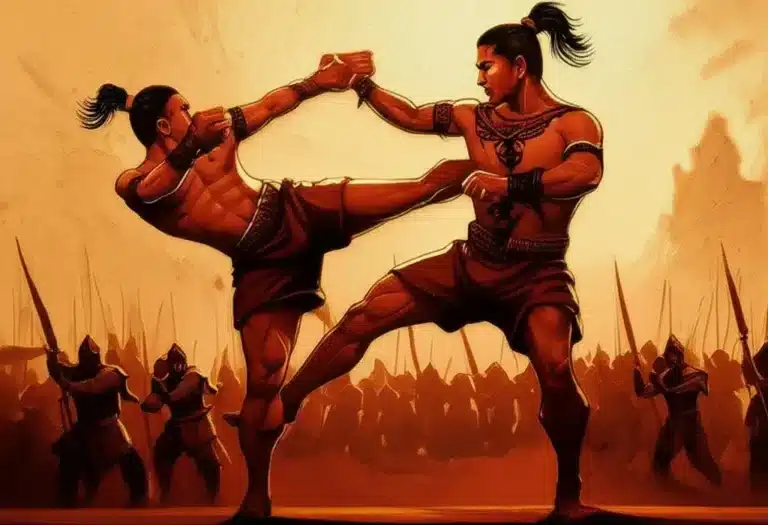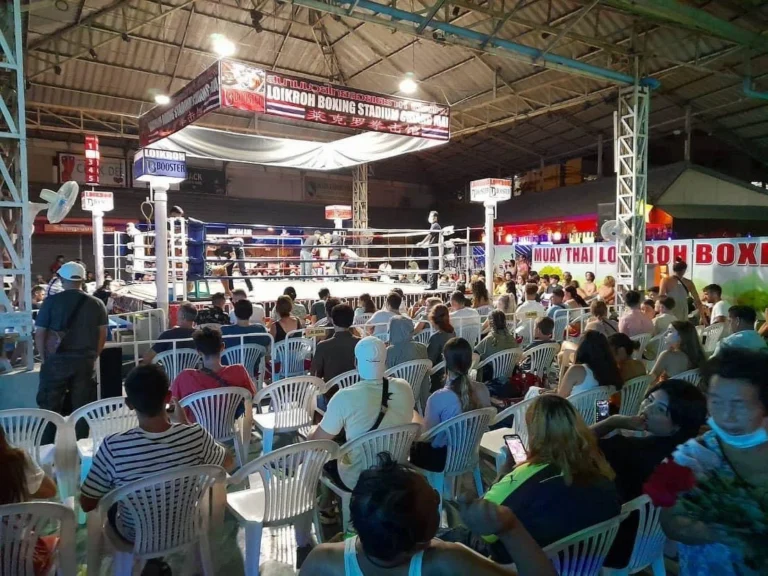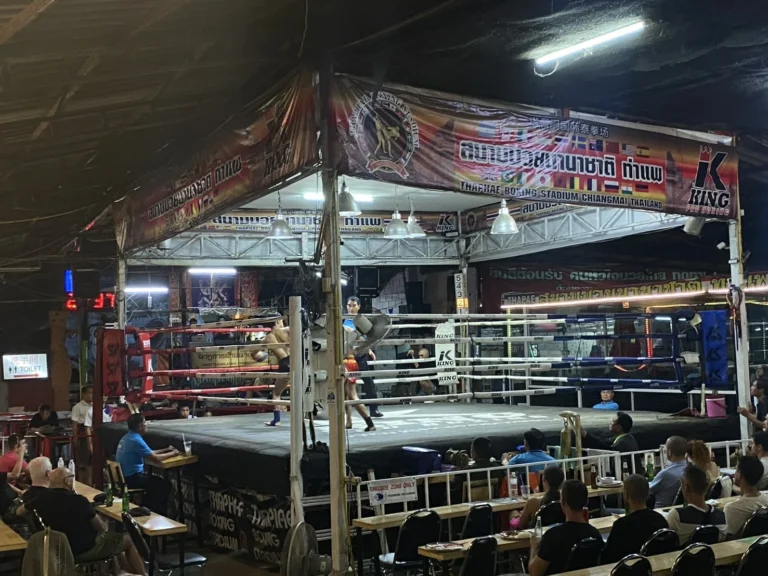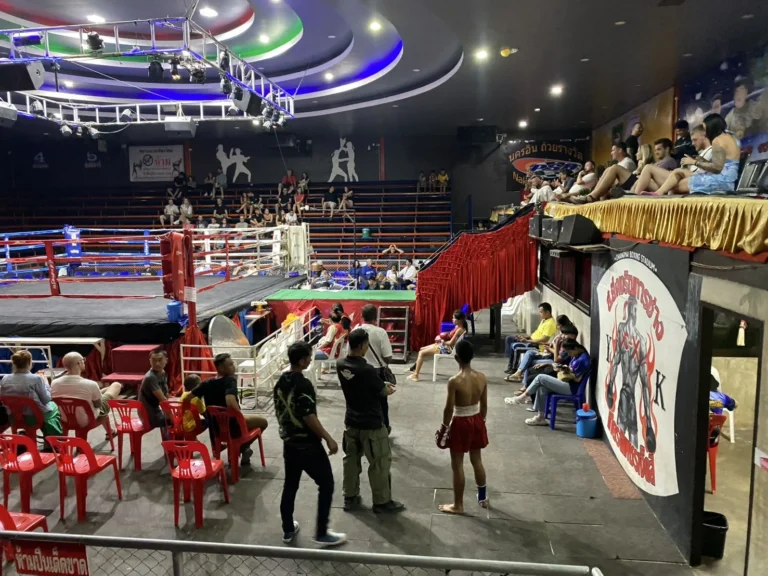Get to know Muay Thai, a martial art known for its strength, usefulness, and old traditions.
People often call it “The Art of 8 Limbs” or “Art of the 8 Limbs.” This fighting sport from Thailand uses the body’s eight main parts as strong weapons: the two fists, two elbows, two knees, and two shins (legs).
Using all these parts to hit makes real Muay Thai a very useful and powerful fighting system. Unlike fighting styles that mostly use punches or kicks, Muay Thai integrates hits from all ranges, offering a full set of stand-up fighting skills.
Learning about the art of Muay Thai is more than just learning a way to exercise. It’s a look into hundreds of years of history and a fighting idea that helped make Thailand what it is.
The Deep Roots of the Art of Muay Thai
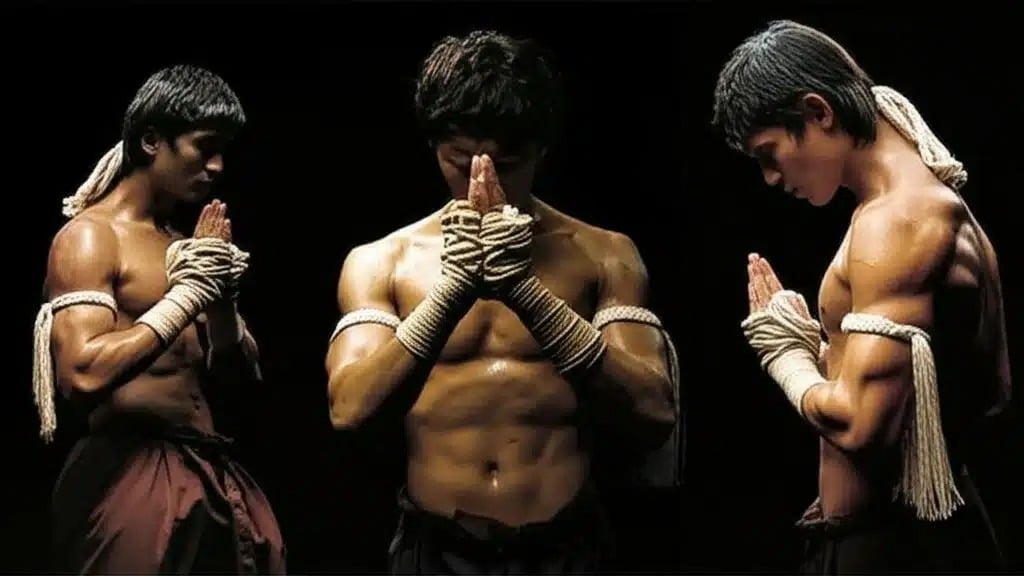
The past of classic Muay Thai is tightly connected to the history of Thailand, which used to be called Siam. Its beginnings go back many hundreds of years. It grew from the old battlefield fighting style called Muay Boran (“ancient boxing”).
Long ago, when fighting hand-to-hand was key for safety, Siamese fighters created this system. They used their bodies as weapons for fighting up close. Old writings from the Sukhothai Kingdom (1238–1438) show that Muay Thai was even taught to royalty. It was seen as a way to train strong fighters for wars against nearby kingdoms.
The “Chupasart,” a war book from this time, showed how each body part could be used in fighting. This helped start the idea of the “Art of Eight Limbs.”
Over time, Muay Thai changed from a battlefield fighting style to a sport. Rules were written down in the early 1900s to make it safer for ring matches. This included adding timed rounds and changing the old rope hand wraps (Khat Chueak) for modern boxing gloves.
But even with these new parts, the main idea of using the entire body as a weapon has stayed a main part of the art.
Defining the 8 Limbs of Muay Thai
The core of what makes Muay Thai “The Art of 8 Limbs” is its systematic use of eight clear points on the body as tools for hitting. These are:
- The two fists (Chok): Used for powerful punches like those in boxing, including jabs, crosses, hooks, and uppercuts. While similar to Western boxing, punches in Muay Thai are often used to set up stronger hits from the other limbs.
- The two elbows (Ti Sok): Strong weapons when fighting up close. Elbows can be used sideways, angled, or upwards. They can cause major cuts and damage. Their sharp edge helps them get past an opponent’s defense well.
- The two knees (Ti Khao): Powerful for hitting the body and head, especially when holding someone close (in the clinch). Knee hits can go to the stomach, sides, or head when an opponent isn’t standing straight.
- The two shins (legs) (Ti Jod): Used for the well-known strong roundhouse kicks (Tae Khao). The shin, which gets used to hitting over time, is for blocking kicks and giving hard hits to the legs, body, or head. Kicks are thrown with the whole body turning, making them very powerful.
Using these eight points together gives a wide and strong set of hitting tools from different distances. This makes it a full stand-up fighting system.
The Strategic Advantage: Why 8 Limbs?

Using eight points to hit gives Muay Thai a big advantage over fighting styles with fewer ways to hit. The wide array of tools makes for a fascinating comparison between Muay Thai and other martial arts like Western boxing (two points – fists) or Karate/Taekwondo (mostly four points – fists and feet).
This large number of hitting tools lets a Nak Muay (Muay Thai fighter) attack and defend well from far away, medium distance, and close up. For instance, while punches work well at medium distance, elbows and knees become key weapons in the clinch or when an opponent comes in close.
The powerful shin kicks can target an opponent’s legs, making it hard for them to move. They can also be aimed at the body or head for hits that can end the fight.
Being able to easily switch between different hitting tools and distances makes Muay Thai a very flexible and good martial art.
Training the Art of 8 Limbs
A basic Muay Thai training regimen is a tough and hard job that builds both physical and mental strength. Common training ways are:
- Pad work: Working with a trainer holding pads to practice hitting with punches, kicks, knees, and elbows with full power.
- Heavy bag training: Making power, proper form, and strength by hitting a heavy bag.
- Sparring: Using learned moves against a training partner in a careful way.
- Clinch work: Practicing holding techniques and hitting with knees and elbows when up close.
Developing strong shins, powerful elbows, and effective knee strikes requires hard work and doing things over and over.
Training is more than just hitting. It includes hard exercise to build heart strength, body strength, and staying power. This is needed to do and take 8-limb hits. This full way of training is needed to become good at real Muay Thai, and it’s important to use the right essential Muay Thai training gear to stay safe and effective.
Beyond Striking: Clinch and Sweeps
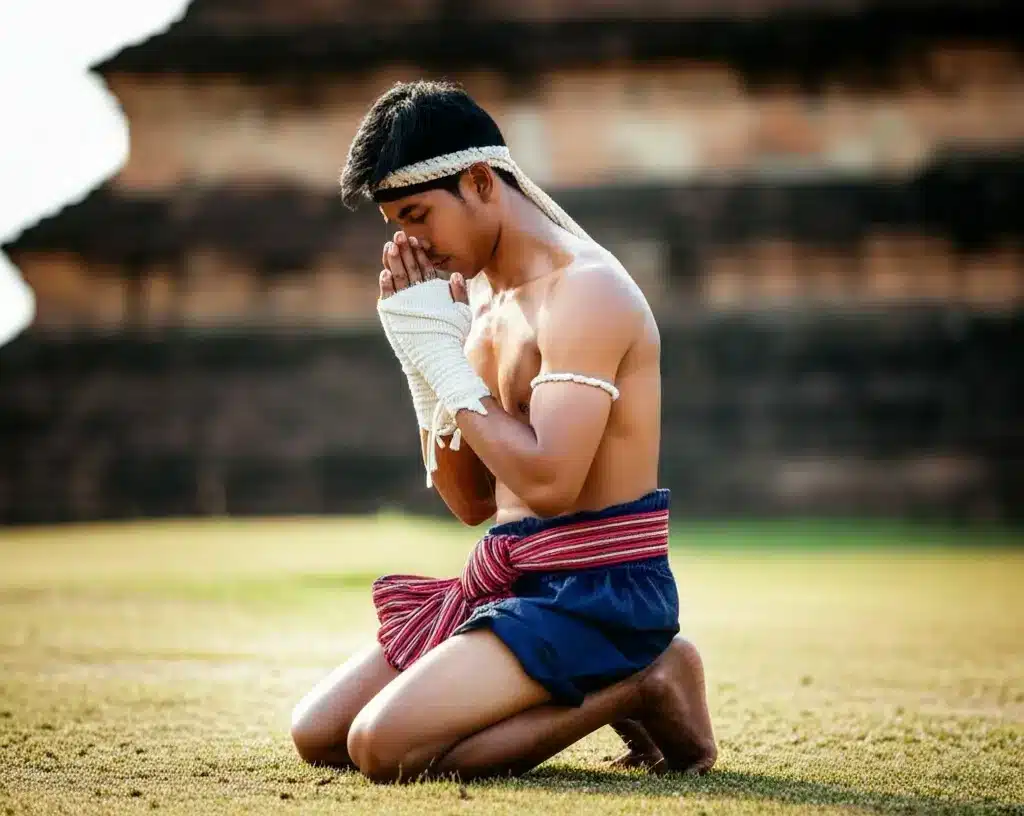
A main part of Muay Thai that works with its hitting moves is using the clinch (sometimes called the “plum”).
The clinch is a close-range holding position where fighters control their opponent’s head and body. They mostly do this to hit with strong knee and elbow strikes. Unlike the clinch in boxing, which is often used to stop the fight for a moment, the Muay Thai clinch is a tool for hitting and stopping hits.
Good use of the clinch helps a fighter control how their opponent stands. It makes it hard for them to hit well. It also gives chances to score points with knees or get ready for sweeps and throws.
Sweeps and throws are moves used to make an opponent lose their balance and fall to the ground. This scores points and shows who is in control. This part of Muay Thai makes the art more complicated and good.
Cultural Significance and Traditions
Muay Thai is much more than just a fighting sport in Thailand. It’s the main sport and a deep part of the country’s culture and who they are. Its importance is shown in different traditions and rituals that are a main part of training.
One of the most important is the Wai Khru Ram Muay. This is a pre-fight ritual fighters do to show respect to their teachers (Kru), parents, people who came before them, and the sport itself. The Wai Khru is when the fighter walks in a circle around the ring and bows. The Ram Muay is a special dance for each fighter. It can show their style and who taught them. This ritual happens with old Sarama music playing. It is seen as a way to honor history, clear the mind, and even ask for good luck.
Muay Thai also has ties to the Buddhist religion. Many fighters ask for good things from monks before big matches. These traditions show the deep religious and cultural background of Muay Thai. They teach being careful, showing respect, and being thankful.
Muay Thai Martial Artists in the Modern Era
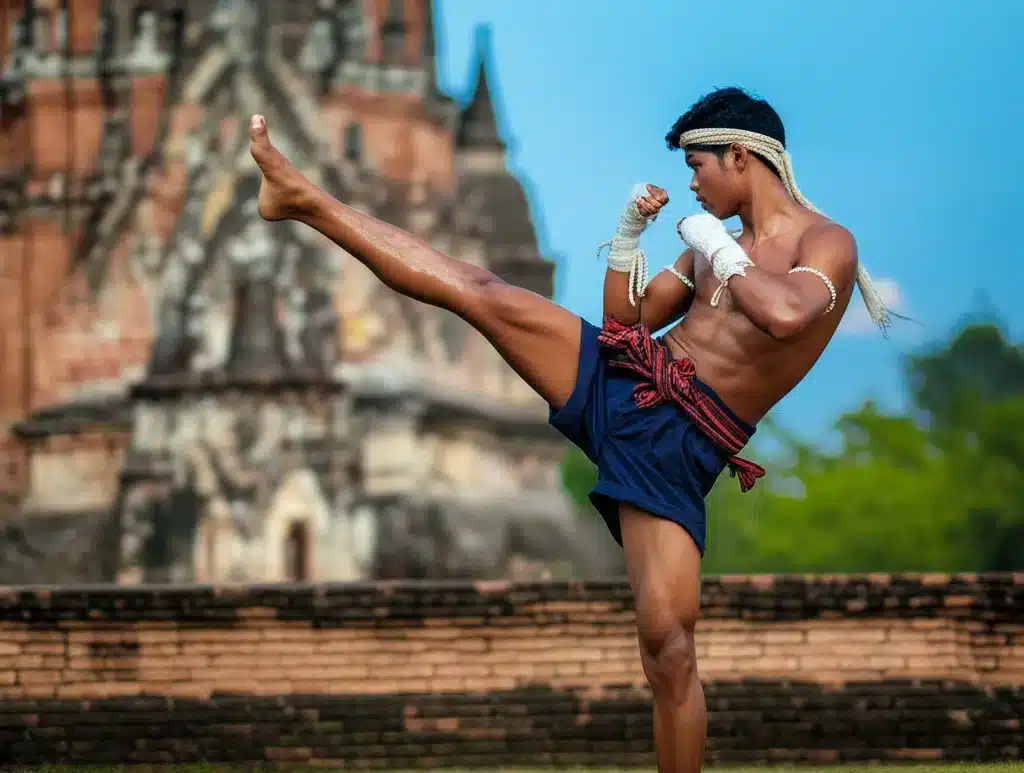
Muay Thai works well. That’s why it has a big effect on mixed martial arts (MMA). Many MMA fighters who do well use Muay Thai hitting moves in their fighting.
Beyond MMA, Muay Thai fighters, called Nak Muay, are known around the world for being skilled and tough. Famous fighters like Samart Payakaroon, known for his great technical skill and switch to boxing, and Buakaw Banchamek, known around the world for the sport with his tough style, have helped many people get into the sport.
Other known Nak Muay include Saenchai, known for his special and fun style, and newer fighters like Superlek Kiatmoo9 and Jonathan Haggerty.
More and more people around the world are getting interested in Muay Thai. Gyms and training places are opening everywhere. This lets more people feel the good things from training the art of 8 limbs. The professional fighting world in Thailand, especially at well-known stadiums like Lumpinee and Rajadamnern, is the top place for many fighters who want to get better. For visitors and residents in Northern Thailand, learning how to watch Muay Thai in Chiang Mai provides a fantastic opportunity to see the sport live at one of the city’s great venues.
Frequently Asked Questions about The Art of 8 Limbs

What are the 8 limbs of Muay Thai?
The 8 limbs of Muay Thai are the eight parts of the body a fighter uses as weapons: the two fists, two elbows, two knees, and two shins (legs).
Why is Muay Thai called the art of 8 limbs?
Muay Thai is called the art of 8 limbs because it uses hits from all eight of these parts. This lets fighters use many ways to attack and defend from different distances. Using the whole body in this way makes it different from many other fighting styles that use hitting.
How does the art of the 8 limbs compare to other martial arts?
The art of the 8 limbs has more ways to hit than styles like Western boxing (only fists) or Karate/Taekwondo (primarily fists and feet). It includes elbows, knees, and strong shin kicks, plus the clinch. This gives a more full stand-up fighting system that is known for working well in real fights and in MMA.
What benefits can you get from training in the art of Muay Thai?
There are numerous benefits to training in the art of Muay Thai that help your body and mind in many ways. It makes your heart and lungs strong, builds body strength and staying power, helps you bend and move easily, and can help with your weight. For your mind, it helps you focus, be careful, stay strong when things are hard, and feel better about yourself. It also helps with stress.
Is Muay Thai effective for self-defense?
Yes, many people think Muay Thai is a very good fighting art for protecting yourself. This is because it has hitting moves for close up and far away. It also uses the clinch for fighting when people are close together.
What is the difference between Muay Thai and Muay Boran?
Muay Boran is the old battlefield fighting art that modern Muay Thai came from. Muay Thai is the sport we see now with rules, rounds, and gloves. Muay Boran is the older, less rule-bound fighting style that used the body as weapons in a more basic way. Today, people mostly do Muay Boran for shows.
Further Reading & Resources
- World Muaythai Council: https://wmc.muaythai.sport/
- Sports Authority of Thailand: https://www.sat.or.th/
- History of Muay Thai: https://muaythai.sport/history-of-muaythai/

